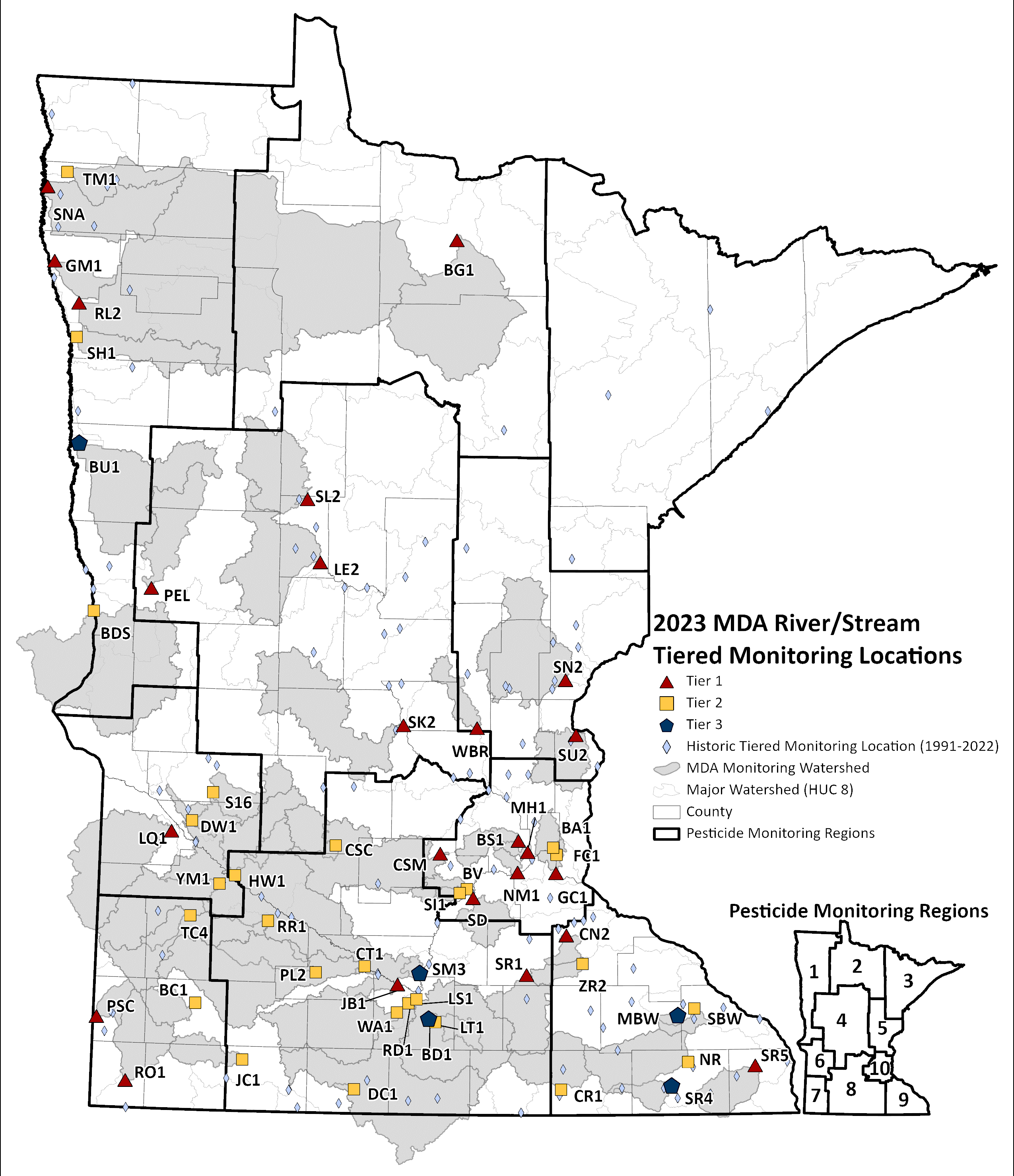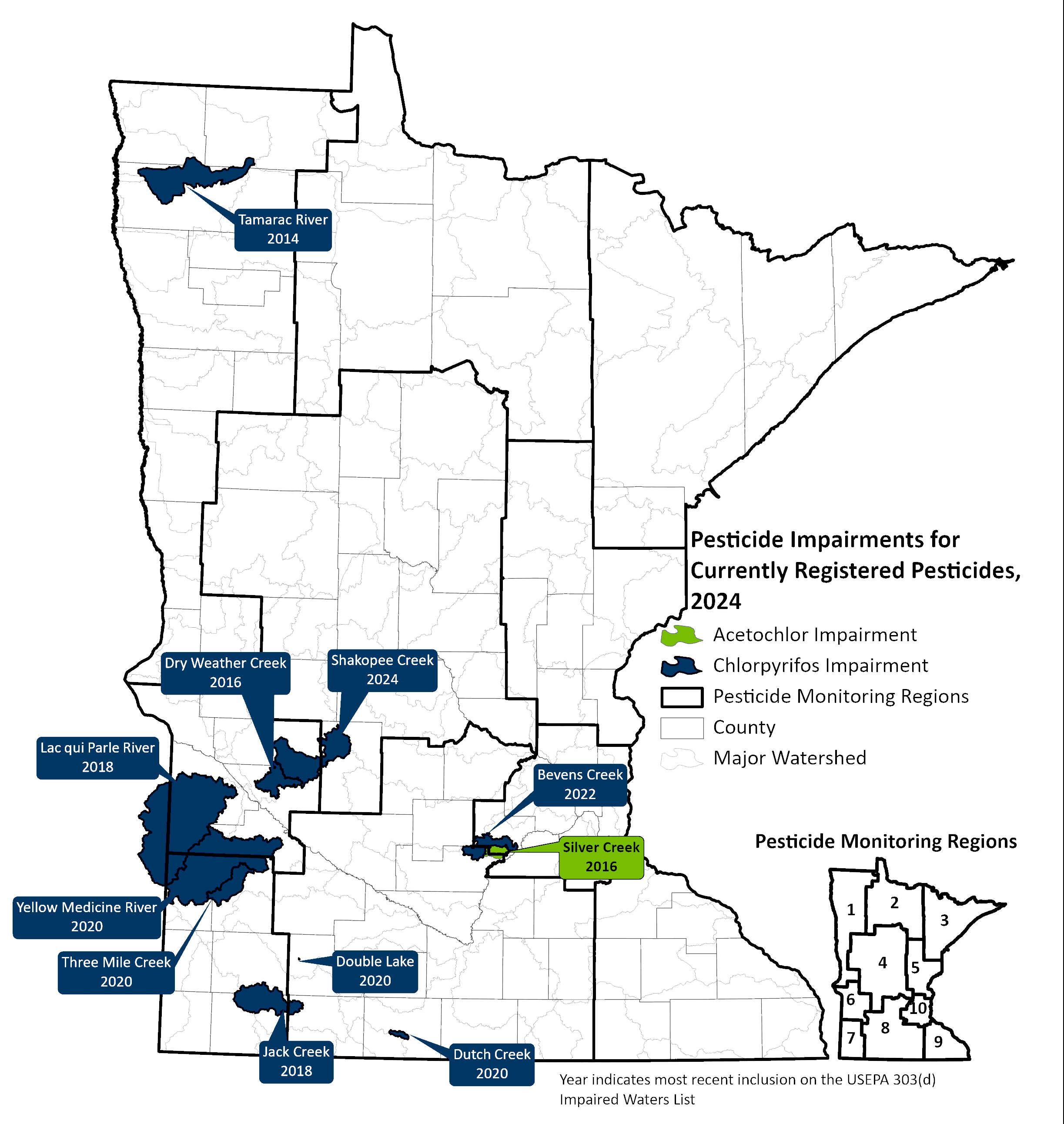Monitoring

History
In 1987, the Minnesota Legislature amended the Minnesota Pesticide Control Law (MN Statute 18B.04). It directed the MDA to determine the impact of pesticides on the environment, including the impacts on surface water and groundwater.
In response to this charge, the MDA initiated a pesticide groundwater monitoring program in 1987. In 1991, surface water monitoring began. The MDA also conducts edge-of-field water quality monitoring for nutrients and sediment. The MDA has one of the most comprehensive pesticide monitoring programs in the country.
Surface Water Monitoring Results
The MDA’s ambient surface water monitoring focused on pesticide sample collection from rivers and streams around the state with some additional monitoring in lakes and wetlands. In 2023, the MDA collected 1,056 pesticide samples from 56 rivers and streams, 49 samples from 4 rainfall monitoring locations, 6 samples from 1 lake, and 54 samples from 25 wetlands. The MDA analyzed up to 186 pesticide analytes during each sample collection event.
River and Stream Monitoring Summary
- The MDA analyzed 186 pesticides and pesticide degradates in 2023.
- Forty-two of the 70 detected pesticide analytes were detected in 10% or less of the samples.
- Detected compounds included 9 fungicides, 37 herbicides, 19 herbicide degradates, 4 insecticides and 1 insecticide synergist.
- Three fungicides, azoxystrobin, carbendazim, and propiconazole, were detected in 19%, 12%, and 9% of samples respectively, no other fungicide had a 2023 detection frequency >3%.
- Three herbicides had a detection frequency greater than 50% including 2,4-D (76%), metolachlor (61%), and atrazine (59%).
- Six herbicide degradates had a detection frequency >50% including hydroxyatrazine (95%), metolachlor ESA (89%), metolachlor OXA (89%), acetochlor ESA (74%), acetochlor OXA (66%), and dimethenamid ESA (50%).
- Various degradates of the herbicides acetochlor, alachlor, atrazine, cyanazine, dimethenamid, isoxaflutole, metolachlor and pyroxasulfone were detected more frequently than their respective parent compound.
- Three neonicotinoid insecticides (clothianidin, imidacloprid, and thiamethoxam) were detected in 11%, 21%, and 4% of samples, respectively. No other insecticide had a detection frequency >1% and chlorpyrifos was not detected.
- The insecticide synergist, piperonyl butoxide was detected in <1% of samples.
- Samples collected during storm flow conditions generally exhibited higher pesticide detection frequencies and concentrations than samples collected during base flow conditions. In 2023, 81% of the detected analytes had a higher detection frequency in stormflow, and 66% of the detected analytes had a higher maximum concentration in storm flow compared to samples collected during baseflow periods.
- In 2023, 77% to 80% of the GC‑MS/MS, LC-MS/MS and glyphosate LC-MS/MS samples were collected during baseflow conditions. This is higher compared to most years with normal rainfall and is consistent with sample collection conditions during the drought of 2021.
- Sixty-seven samples had a concentration above an applicable numeric water quality reference value, including acetochlor (17), atrazine (1), clothianidin (16), and imidacloprid (33).
- All detections above an applicable numeric water quality reference value require a duration assessment to determine if both the numeric and duration component of the reference value was exceeded to fully assess risk to aquatic life.
- Minnesota water quality standards are available for acetochlor and atrazine. The Minnesota Pollution Control Agency (MPCA) will assess the water quality data, as well as the concentration duration, for any applicable MN Ch. 7050 standard violations.
- Clothianidin and imidacloprid do not have Minnesota state standards and were compared to United States Environmental Protection Agency (USEPA) aquatic life benchmarks.
- Acetochlor, atrazine, clothianidin, and imidacloprid were detected above the numeric component of the applicable reference value in 3%, <1%, 5% and 10% of samples, respectively.
- All detections above an applicable numeric water quality reference value require a duration assessment to determine if both the numeric and duration component of the reference value was exceeded to fully assess risk to aquatic life.
- Glyphosate was detected in 2% of samples.
- Dicamba was detected in 4% of samples.
Surface Water Pesticides of Concern
Following guidance in the Pesticide Management Plan, the MDA has designated 5 pesticides as a “surface water pesticide of concern”. This designation is made by the Commissioner of Agriculture following detection(s) of a pesticide in a surface waterbody at a concentration of concern relative to a water quality reference value, and that the detection(s) is not the result of misuse or unusual or unique circumstances. The designation prompts actions to address the pollutant including the development and promotion of BMPs, additional monitoring, and increased data analysis.
| Active Ingredient | Type | Example Trade Name* |
|---|---|---|
| Acetochlor | Herbicide | Harness, Confidence, Volley NXT |
| Atrazine | Herbicide | Astrex, Acuron, Callisto Xtra |
| Chlorpyrifos | Insecticide | Duraguard, Pyrofos |
| Clothianidin | Insecticide | Arena, Belay, Poncho |
| Imidacloprid | Insecticide | Admire, Gaucho, Skyraide |
*Reference to commercial products or trade names is made with the understanding that no discrimination is intended, and no endorsement is implied.
For more information on this designation and the supporting resources for the determination to designate clothianidin and imidacloprid, visit the surface water pesticides of concern page.
Surface Water Pesticide Impairments
There were 11 Minnesota waterbodies that were designated by the MPCA as impaired for a currently registered pesticide on the 2024 USEPA 303(d) Impaired Waters List after failing to meet a water quality standard. Additionally, 8 waterbodies that were included on a previous USEPA 303(d) Impaired Waters List have been removed from the list after meeting the water quality standard. Inclusion and removal from the USEPA 303(d) Impaired Waters List resulted from the MPCA assessment of the MDA surface water pesticide data in comparison to Minnesota water quality standards.

Current and historic Minnesota pesticide impairments for currently registered pesticides
Currently designated as impaired on the USEPA 303(d) Impaired Waters List
| Analyte | Impaired Waters List Addition Year |
Waterbody | Monitoring Location County |
Minnesota Water Quality Standard Violation that Resulted in Impairment |
|---|---|---|---|---|
| Acetochlor | 2016 | Silver Creek | Carver | chronic (3,600 ng/L) |
| Chlorpyrifos | 2022 | Bevens Creek | Carver | maximum (83 ng/L) |
| Chlorpyrifos | 2020 | Double Lake | Cottonwood | chronic (41 ng/L) |
| Chlorpyrifos | 2016 | Dry Weather Creek | Chippewa | maximum (83 ng/L) |
| Chlorpyrifos | 2020 | Dutch Creek | Martin | maximum (83 ng/L) |
| Chlorpyrifos | 2018 | Jack Creek | Jackson | maximum (83 ng/L) |
| Chlorpyrifos | 2018 | Lac qui Parle River | Lac qui Parle | maximum (83 ng/L) |
| Chlorpyrifos | 2024 | Shakopee Creek | Swift | maximum (83 ng/L) |
| Chlorpyrifos | 2014 | Tamarac River | Marshall | maximum (83 ng/L) |
| Chlorpyrifos | 2020 | Three Mile Creek | Lyon | maximum (83 ng/L) |
| Chlorpyrifos | 2020 | Yellow Medicine River | Yellow Medicine | maximum (83 ng/L) |
Historic impairments removed from the USEPA 303(d) Impaired Waters List
| Analyte | Impaired Waters List Addition Year |
Impaired Waters List Removal Year |
Waterbody | Monitoring Location County |
Minnesota Water Quality Standard Violation that Resulted in Impairment |
|---|---|---|---|---|---|
| Acetochlor | 2008 | 2014 | Beauford Ditch | Blue Earth | chronic (3,600 ng/L) |
| Acetochlor | 2008 | 2014 | Le Sueur River | Blue Earth | chronic (3,600 ng/L) |
| Chlorpyrifos | 2018 | 2024 | Beauford Ditch | Blue Earth | maximum (83 ng/L) |
| Chlorpyrifos | 2018 | 2024 | Beaver Creek | Murray | maximum (83 ng/L) |
| Chlorpyrifos | 2018 | 2024 | Chetomba Creek | Renville | maximum (83 ng/L) |
| Chlorpyrifos | 2014 | 2022 | Grand Marais Creek | Polk | maximum (83 ng/L) |
| Chlorpyrifos | 2012 | 2018 | Seven Mile Creek | Nicollet | maximum (83 ng/L) |
| Chlorpyrifos | 2018 | 2024 | Sleepy Eye Creek | Redwood | maximum (83 ng/L) |
Visit the MPCA Minnesota Impaired Waters List for more information.
Chlorpyrifos Response Plan was developed in response to continued detections of chlorpyrifos in rivers, streams and lakes and the determination of chlorpyrifos water quality impairments of rivers and streams in agricultural areas of Minnesota.
Data Availability and Future Work
All of the pesticide data collected as part of the MDA's ambient monitoring program is publicly available through the Water Quality Portal or by contacting the MDA. The MDA will continue to improve its program to expand monitoring to new locations and to include additional pesticide analytes, as resources and needs permit. The MDA is committed to maintaining its long-term data record to allow for continued assessment of the impacts of pesticides on surface water from routine use.

